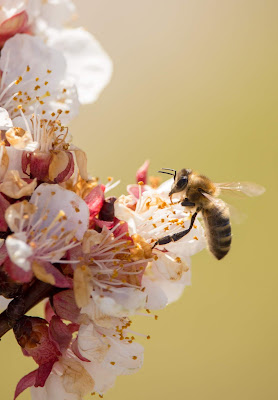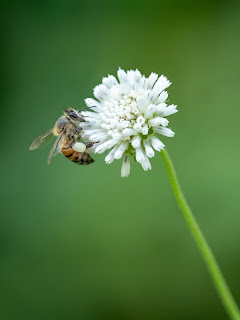done cautiously.
Pyrethrin insecticides offer a reasonable solution for the environmentally conscious gardener. Derived from Chrysanthemum cinerarifolium (a flower genus that includes both the Chrysanthemum and the Daisy), these extracts have been used since ancient times to fight insect pests on both people and plants. Pyrethrin insecticides have been around for so long because they work so well. But, before you spray this power to kill should be taken into consideration.
 For the purposes of this blog, I am going to focus on bees. Although Honey Bees are the number one pollinator in the world and their existence is currently threatened, they are by no means the only pollinators. However, the efforts one can take to reduce harm to bees will also work to protect beneficial insects, other pollinating insects and even non-insect pollinators.
For the purposes of this blog, I am going to focus on bees. Although Honey Bees are the number one pollinator in the world and their existence is currently threatened, they are by no means the only pollinators. However, the efforts one can take to reduce harm to bees will also work to protect beneficial insects, other pollinating insects and even non-insect pollinators.The dangers to bees from pyrethrins are the same as the danger from any other insecticide, but pyrethrins do not persist in the environment as other more toxic insecticides will. They will, instead, break down rapidly, especially when exposed to natural sunlight. This makes them by far the superior choice for putting in your garden or grow.
 Bee deaths from insecticides come from a combination of events; a perfect storm of pollinator danger. Most fatalities happen when pesticides are applied to flowering crops and then allowed to drift at a time when bees are actively foraging. To address and lessen these hazards, we can break them down to several things you should be aware of: temperature, drift/distance from treated area and timing of application.
Bee deaths from insecticides come from a combination of events; a perfect storm of pollinator danger. Most fatalities happen when pesticides are applied to flowering crops and then allowed to drift at a time when bees are actively foraging. To address and lessen these hazards, we can break them down to several things you should be aware of: temperature, drift/distance from treated area and timing of application.Temperature: Bees forage only in sunlight and love high temperatures, so they are out and about on bright summer days. Additionally, sprays are more likely to vaporize under high temp and this vapor can be an even greater threat than the spray itself. Which means you should only apply insecticides in the late evening or night. Early morning applications can be done as long as you are sure that the insecticide will have dried before bees can get to it.
Drift/Distance from treated area:
• Pesticide drift is caused by multiple factors: weather, application method, equipment settings and spray formulation. Often, spraying will occur on flowering crops like fruits and vegetables and drift onto flowering plants like weeds and wildflowers, effectively stopping insect activities in both areas.
 • Insecticides applied in one area can affect insects and wildlife more than a mile away. Create a buffer zone around your spray area. Most bees forage 1-2 miles from their hive, but can travel much farther; so the larger the buffer the better.
• Insecticides applied in one area can affect insects and wildlife more than a mile away. Create a buffer zone around your spray area. Most bees forage 1-2 miles from their hive, but can travel much farther; so the larger the buffer the better.• Be aware of the weather when you spray. Even light wind can enable drift and low humidity with high temperatures are optimal conditions for drift. Conversely, moderate temperatures with some humidity decrease the potential for drift.
• Carefully calibrate your equipment (smaller droplets drift more) and avoid aerial applications and mist blowers.
 Here are some more tips to manage your drift.
Here are some more tips to manage your drift.Timing of application: If possible, never apply pesticides to flowering plants. Insect control should take place either before or after flowering. If application is unavoidable, a pesticide with a short residual rate (pyrethrins are perfect!) can be applied in the evening when temperatures are under 60 degrees.
• Before spraying, remove any flowering weeds around the area you will be spraying. This will reduce the temptation for pollinators and help form your buffer zone.
• Avoid spraying any favorites of pollinators.
• If possible, use pyrethrin insecticides in liquid formulations. Products with dusts or granules can easily stick to bee’s hairs and be taken back to the hive and cause damage there.
• Always read the manufacturer’s label and apply insecticide at the minimum recommended rate. Never exceed the recommended amount.
If you would like more information on how to look out for pollinators, I highly recommend you check out the Xerces Society. They have been in the forefront of invertebrate conservation since 1971 and really know their stuff.

Looking for an effective, organic garden pest control spray? Check out the great organic pyrethrin-based liquid insecticides from our partner MGK Gardening - a proud producer of botanical pest control solutions for 100 years!
Submitted by Pam






Thank you!
ReplyDelete